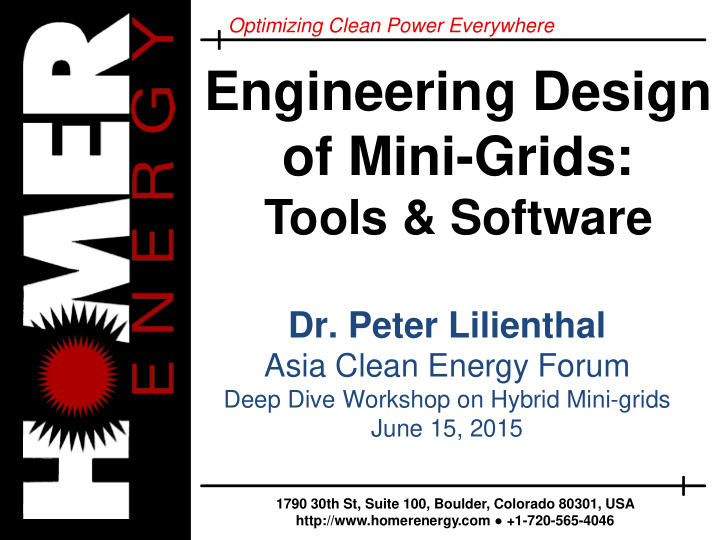



Optimizing Clean Power Everywhere Engineering Design of Mini-Grids: Tools & Software Dr. Peter Lilienthal Asia Clean Energy Forum Deep Dive Workshop on Hybrid Mini-grids June 15, 2015 1790 30th St, Suite 100, Boulder, Colorado 80301, USA http://www.homerenergy.com ● +1-720-565-4046
Modeling Challenge • Solar and wind are variable – Needs integration with dispatchable resources • Smaller projects need simpler tools
Different Tools for Different Purposes Renewable Advocates Power HOMER Financiers Engineers Model Utility Operators HOMER as a communication tool www.homerenergy.com
Too Many Choices Hydro Geothermal Micro-grids Demand Response Smart grids Clean Power Everywhere
What is best? • Depends on the application – Resources – Loads – Equipment prices – Equipment performance • A confused mind says “No!” • HOMER fits the pieces together Clean Power Everywhere
HOMER • Industry standard for hybrid micro-grids – Conventional resources – Renewable resources – Storage – Load Management • Afternoon Deep Dive Workshop • Full-day training on Saturday
HOMER • NREL: 1992-2009 • Original developers now at HOMER Energy • 125,000+ users in 193 countries 160,000 140,000 120,000 100,000 80,000 60,000 40,000 20,000 0 2010 2011 2012 2013 2014 Q1_15
HOMER Analysis Layers • Simulation – Accurate analysis of time varying loads and resources require an hour- by-hour analysis for entire year Sensitivity Analysis • Optimization Optimization – Find the least cost solution Simulation • Sensitivity Analysis Energy Balance – The data is never “good enough”. – What if….?
HOMER has a Global Reputation “We spent a lot of money developing our own model, but threw it away because everyone kept asking for our HOMER results.” Bruce Levy, CEO, TDX Power
What’s New with HOMER Pro New components Library – Thermal load controller – Store cost data in the library – – Concentrating PV All components, loads, settings and resource in library – MPPT/Dedicated PV Inverter – Library management tool – Hydrokinetic New Results – Improved Components Choose parameters for summary tables – Sort and filter on any output – Grid-connected battery – Direct results export to .CSV (spreadsheet format) – Grid outages New Input capabilities – • Scheduled and random Built-in default load profiles – Obtain resource data by clicking on a – Up to 20 generators map or typing address – Up to 10 PV arrays APIs – Wind turbine losses – Application Programming Interfaces – – Maintenance schedules Custom dispatch modules Parallel processing – Minimum generator runtimes – Fuel minimization http://www.homerenergy.com
Optimal System Design • What kind of system is best under which conditions?
Random Outages • Simple Diesel is best if outages are infrequent. • Simple PV-Battery best if outages are short • Hybrids are best in most cases
Operational Analysis AC Primary Load PV Pow er Diesel Pow er Battery Pow er 5 Power (kW) 0 -5 Jul 10 Jul 11 • When is backup power needed?
Policy Analysis Levelized Cost of Energy vs. Max. CO2 Emissions 1.2 1.0 Levelized Cost of Energy ($/kWh) 0.8 0.6 0.4 0.2 0.0 0 5,000 10,000 15,000 Max. CO2 Emissions (kg/yr) • Cost of emission constraints
Penetration Metrics Maximum instantaneous 70.1% Peak load 39.9% Generation capacity 34.0% Energy production 12.5% Renewable fraction 11.6% Fuel savings 8.7% • Six very different metrics for the same system – 85 kW of PV with a 213 kW Peak load – 1% curtailed energy http://www.homerenergy.com
Diesel grid parity
Clean Power Evolution • Large utilities • Smaller systems – Security obstacles – Liquid fuels from oil – Regulatory obstacles – High renewable penetrations http://www.homerenergy.com
Recommend
More recommend